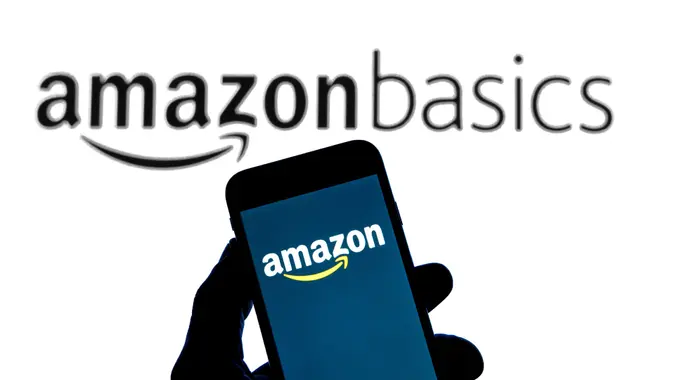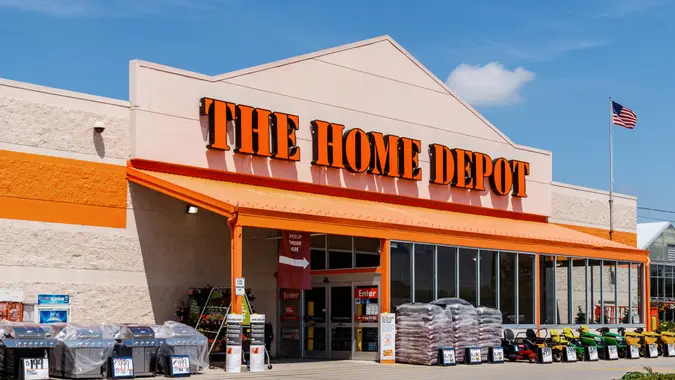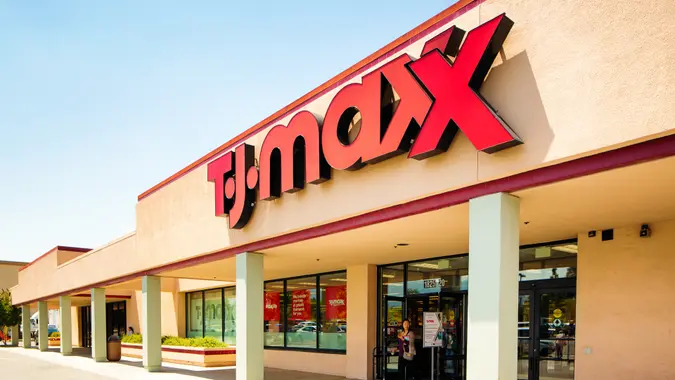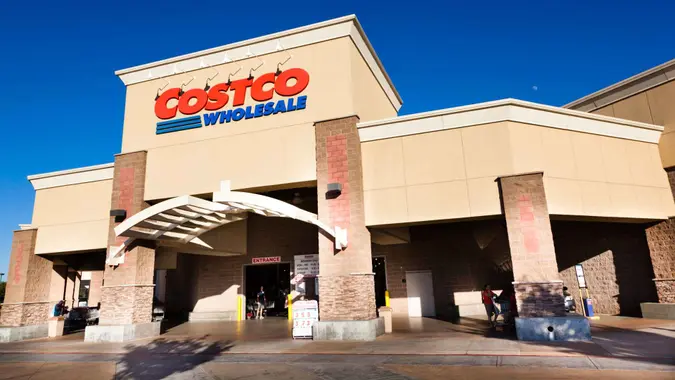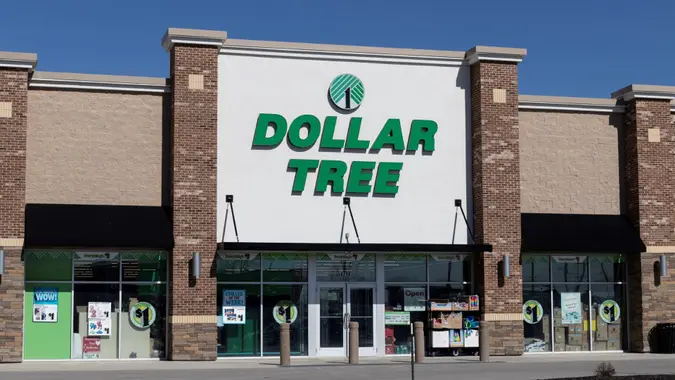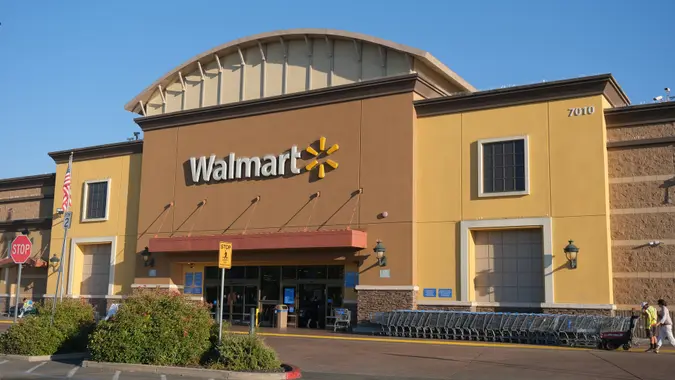How President-Elect Trump’s Win Could Impact the Price of Your Monthly Trip to Costco

Commitment to Our Readers
GOBankingRates' editorial team is committed to bringing you unbiased reviews and information. We use data-driven methodologies to evaluate financial products and services - our reviews and ratings are not influenced by advertisers. You can read more about our editorial guidelines and our products and services review methodology.

20 Years
Helping You Live Richer

Reviewed
by Experts

Trusted by
Millions of Readers
Costco fans buy memberships because they don’t like to shop around. They pay to join knowing that, in most cases, Costco sells nearly everything people buy for cheaper than the competition sells it, so they can save money.
But with all their eggs in one wholesale chain basket, what changes can they expect a second Trump administration to bring to their monthly Costco bill? No one knows for sure how many of President-elect Donald Trump’s proposals will actually take effect or what impact they’ll have if they do.
Analysts speculate that immigration crackdowns could increase Costco’s labor costs, but that corporate tax cuts could provide a financial tailwind.
However, one thing is clear. Trump’s cornerstone trade policies could affect your Costco bill — and there’s a record of how his policies impacted the store’s prices the first time around.
Also, find out how Trump’s proposed policies could affect the cost of groceries overall.
Will Costco Get More Expensive? It Did Last Time
At the end of May 2019, Costco CFO Richard Galanti told investors on an earnings call, “At the end of the day, prices will go up on things.”
There was no stopping it.
Fortune reported that, until that point, tariffs were modest and not concentrated in the kinds of consumer goods that are Costco’s bread and butter. However, Trump’s trade war and the rising cost of Chinese imports had brought the battle to the warehouse club’s doorstep.
Tariffs on Chinese consumer goods had been 10%, a tax that the value chain could contain in the short term with suppliers and retailers both taking a hit on the margins. But when Trump increased the tax to 25%, there simply were no more margins to play with. Sellers like Costco had to raise prices at the retail level on everything from fresh produce and footwear to apparel and consumer electronics to luggage, furniture, vacuums and bikes.
CNBC reported that, on the same earnings call, Galanti told investors that the best Costco could hope for was to be the last to raise prices and the first to drop them when costs decreased. Ultimately, Trump’s tariffs had made price increases inevitable, and it’s difficult to imagine the same scenario not playing out if Trump goes through with expanded tariffs in 2025 — but this time, on a much grander scale.
If Trump Is Serious, Costco Has a China Problem
This time around, Trump’s proposals are far more severe, including a 60% tax on Chinese goods and a 20% tariff on everything else the U.S. imports, according to CNBC — and that will hit Costco especially hard.
According to the international trade data platform Observatory of Economic Complexity (OEC), China is the most common country of origin for Costco merchandise by a mile. Costco received five figures worth of shipments from China in 2024, compared to just a few hundred from the No. 2 closest international manufacturing rival.
Costco’s shipments came mostly from these five countries:
- China: 10,800 shipments
- Vietnam: 767 shipments
- Italy: 249 shipments
- Norway: 162 shipments
- Cambodia: 145 shipments
This Time Around, There Will Be Nowhere for Costco To Hide
On May 31, 2019, just as Trump’s trade war engulfed the consumer goods that Costco became famous for selling at consistently low prices, CNBC reported that its long-time business model was under stress.
Its heavy reliance on the Chinese imports that were now in Trump’s crosshairs forced the company to diversify its supply chain and seek out new suppliers in other countries — but this time, there won’t be any safe manufacturing havens for Costco to pivot to.
Trump’s first trade war targeted China specifically and placed tariffs only on certain products and materials from some other countries. This time, Trump is proposing a nearly universal 20% tariff on just about everything the U.S. imports, with Chinese goods facing tariffs of three times that amount.
That could force Costco to turn to another source of revenue that most other chains can’t tap.
Costco Could Also Raise Its Membership Fees
Utpal Dholakia, an independent consultant and marketing professor at Rice University, conducted a case study of Costco’s business model. Its core strategy is never to mark up prices above 14% over cost for branded items or 15% over cost for house brands like Kirkland Signature.
It uses a three-pronged profit-generating strategy to sustain that policy.
- Costco runs ultra-lean, selling directly to consumers in bulk in no-frills, self-service warehouse facilities.
- Costco uses its extraordinary buying power to leverage sellers into low-cost volume purchasing.
- Costco charges membership fees.
According to Statista, Costco has consistently increased its membership fee revenue every year for the last six years, from $3.14 billion in 2018 to $4.58 billion in 2023.
Tariffs would break one of Costco’s three main profit levers — a 20% or 60% tax would force suppliers to charge Costco more, no matter how hard the giant squeezes. Therefore, Costco might have to pull its third profit lever and raise membership fees to keep its promise of selling its inventory at just over cost.
Editor’s note on political coverage: GOBankingRates is nonpartisan and strives to cover all aspects of the economy objectively and present balanced reports on politically focused finance stories. You can find more coverage of this topic on GOBankingRates.com.
 Written by
Written by  Edited by
Edited by 



